

e2studio开发LPS28DFW气压计(1)----轮询获取气压计数据
描述
概述
本文将介绍如何使用 LPS28DFW 传感器来读取数据。主要步骤包括初始化传感器接口、验证设备ID、配置传感器的数据输出率和滤波器,以及通过轮询方式持续读取气压数据和温度数据。读取到的数据会被转换为适当的单位并通过串行通信输出。
最近在弄ST和瑞萨RA的课程,需要样片的可以加群申请:615061293 。
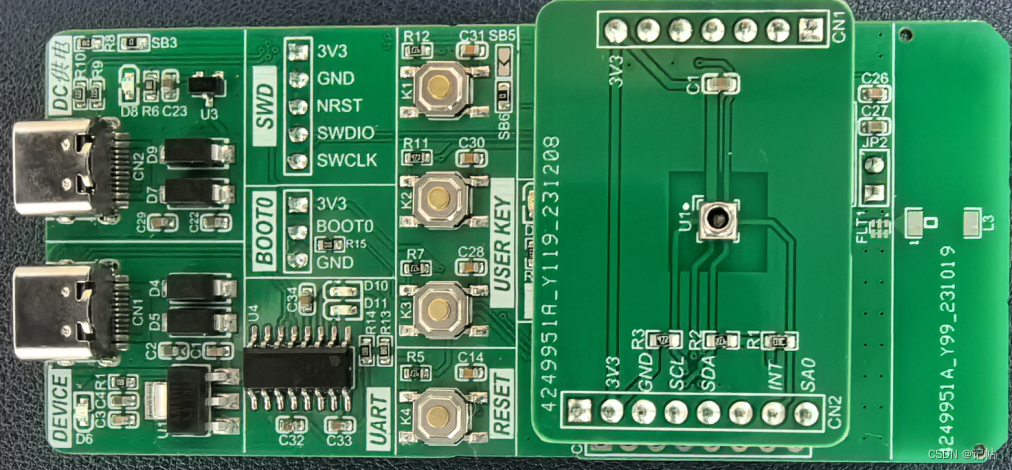
视频教学
[https://www.bilibili.com/video/BV1ti4y1q7Cy/]
样品申请
[https://www.wjx.top/vm/OhcKxJk.aspx#]
完整代码下载
[https://download.csdn.net/download/qq_24312945/88715394]
产品特性
LPS28DFW 是一款高性能的压阻式绝对压力传感器,设计用于提供精确的气压测量。这款传感器特别适合于个人电子和消费类产品,因为它结合了多种先进特性。该传感器以其低功耗和低噪声性能著称,使其在电池供电的便携设备中尤为理想。 LPS28DFW 的封装为陶瓷 LGA 类型,带有金属盖,这种设计既提供了水阻性能,又保持了灵活性,金属盖可以接地或在电路板布局中保持电气浮动。这款传感器能够在 -40°C 至 +85°C 的温度范围内稳定运作,确保在多种环境条件下的可靠性。 此外,它提供两种全尺度的绝对压力测量模式,精度高达 0.5 hPa,配合低至 0.32 Pa 的传感器噪声。内嵌的温度补偿功能进一步增强了其测量准确性。LPS28DFW 还支持高达 200 Hz 的可调输出数据速率 (ODR) 和 24 位的压力数据输出。
通信模式
对于LPS28DFW,可以使用IIC进行通讯。 最小系统图如下所示。
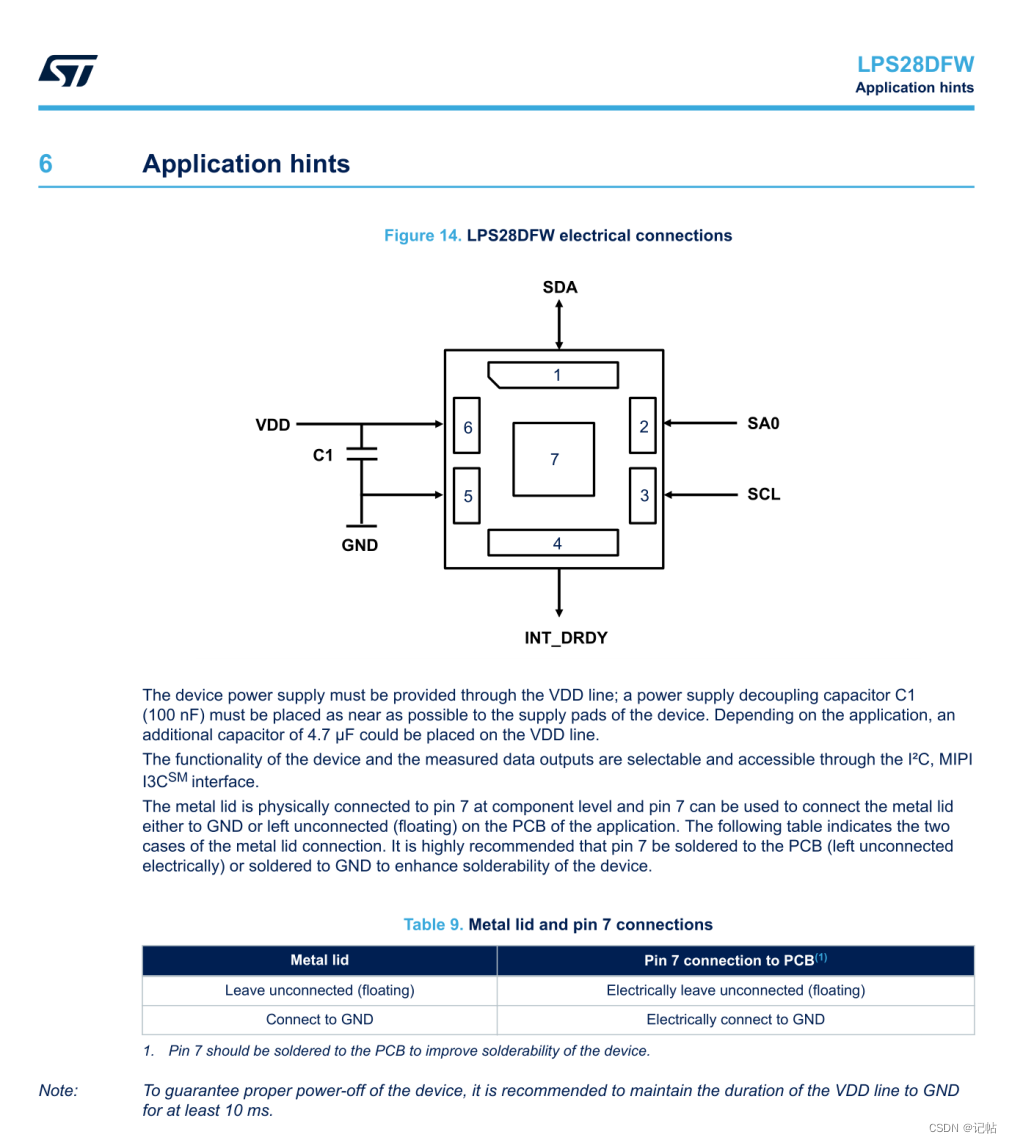
本文使用的板子原理图如下所示。
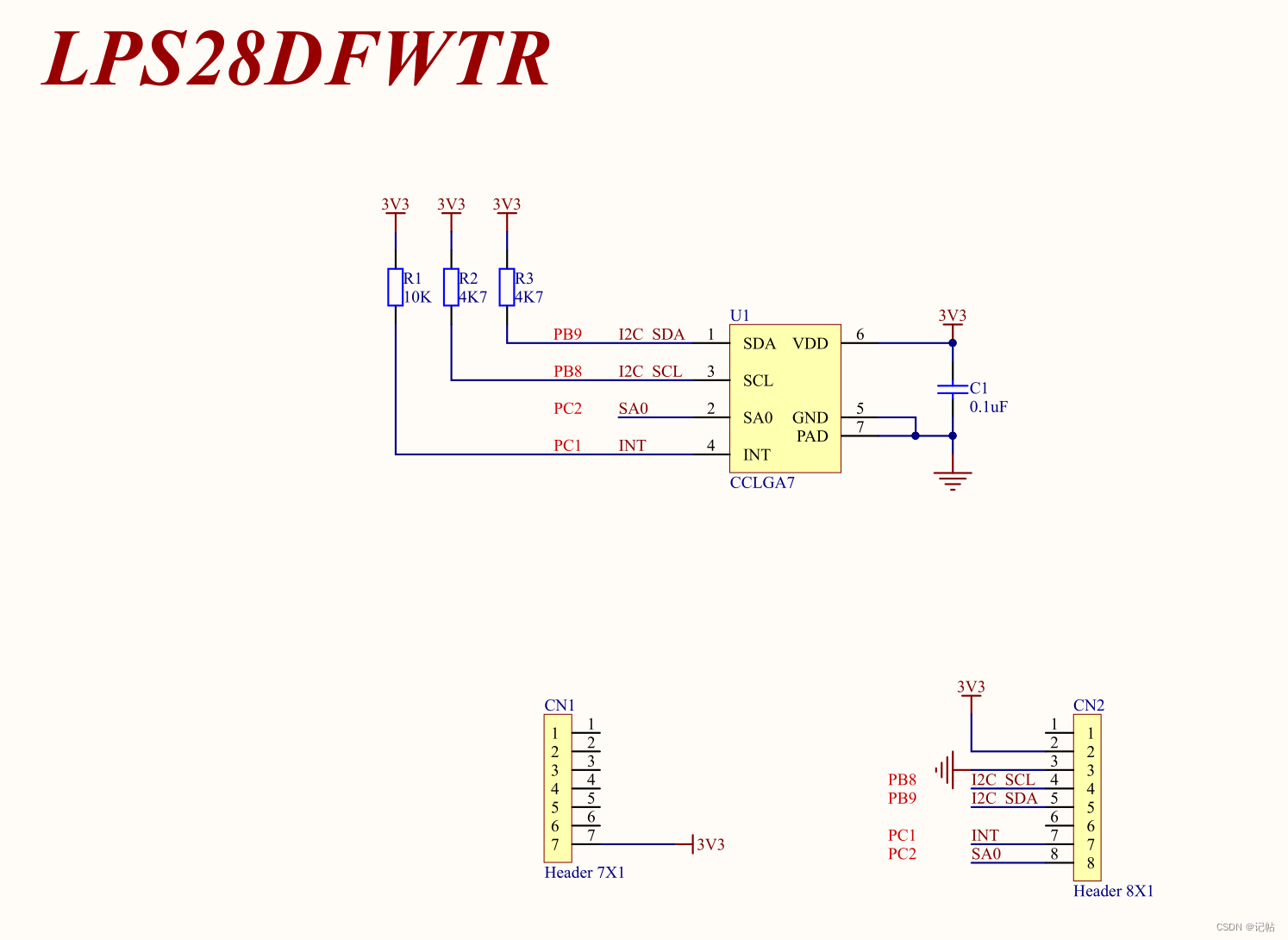
速率
该模块支持的I2C速度最快位快速模式+(1M)。
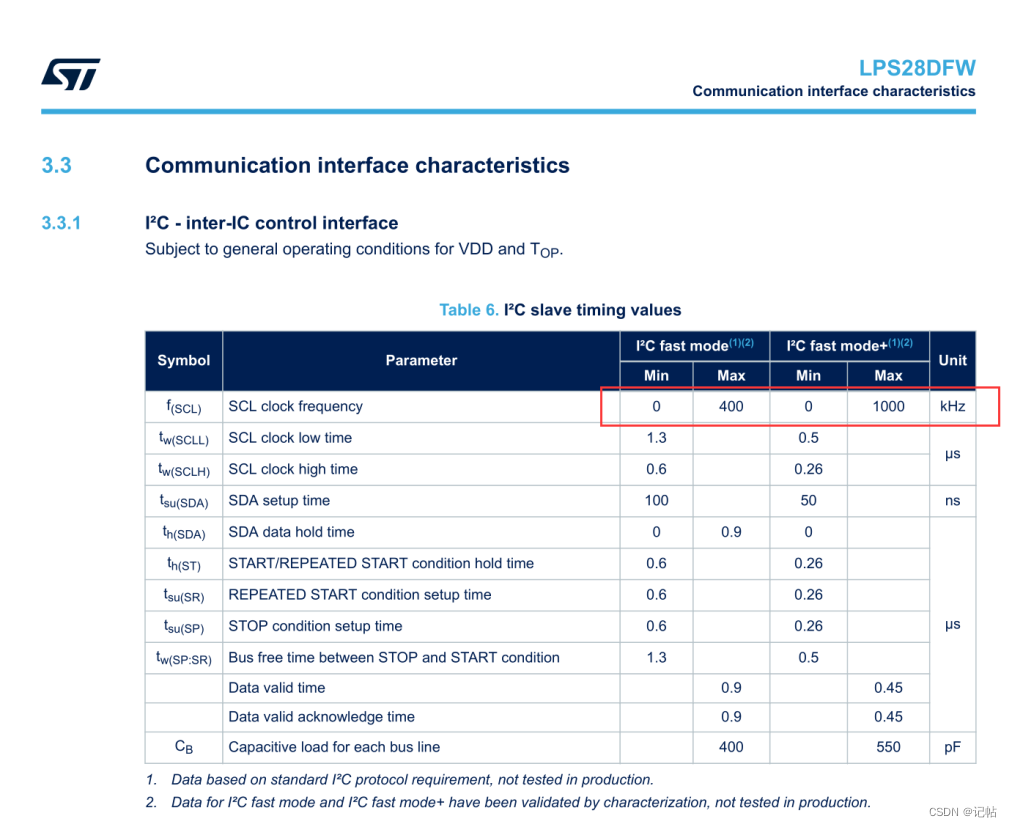
新建工程

工程模板
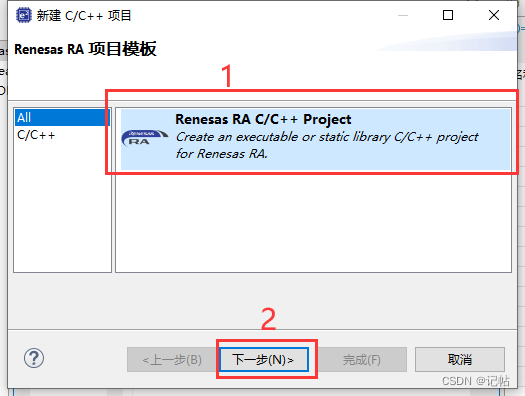
保存工程路径
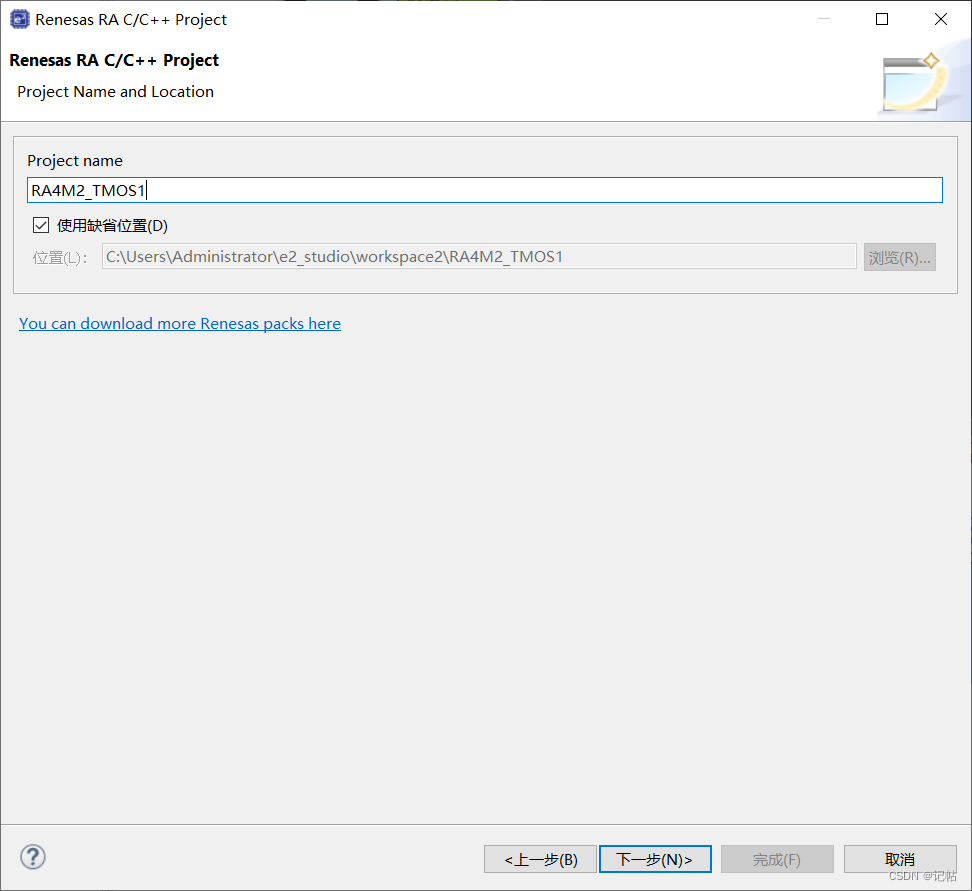
芯片配置
本文中使用R7FA4M2AD3CFL来进行演示。
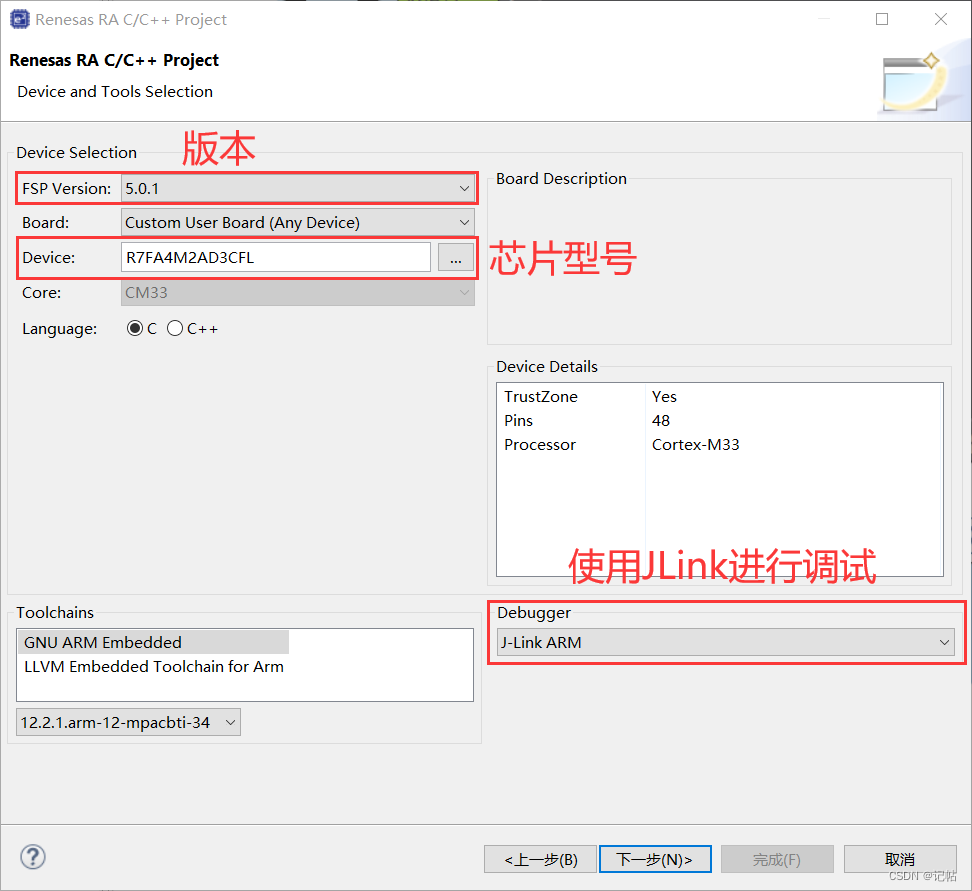
工程模板选择

时钟设置
开发板上的外部高速晶振为12M.

需要修改XTAL为12M。
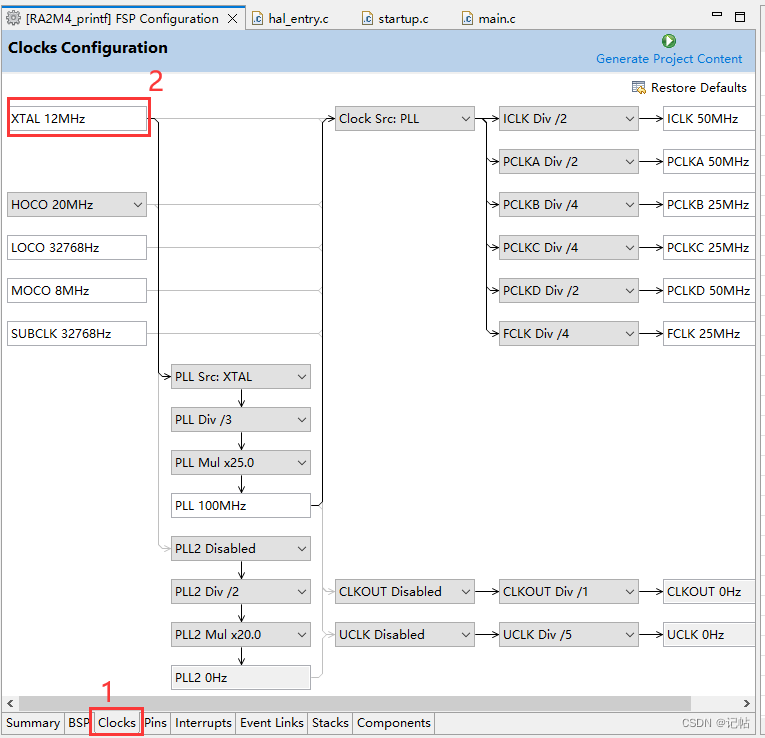
UART配置
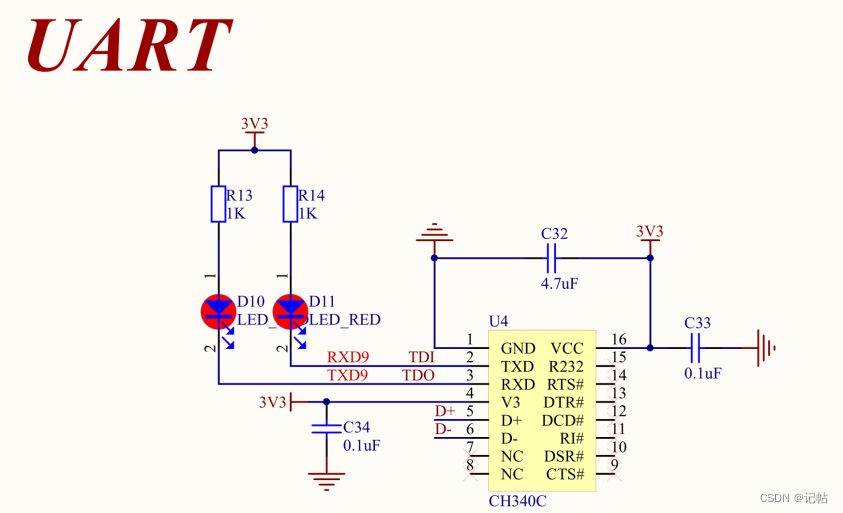
点击Stacks->New Stack->Driver->Connectivity -> UART Driver on r_sci_uart。
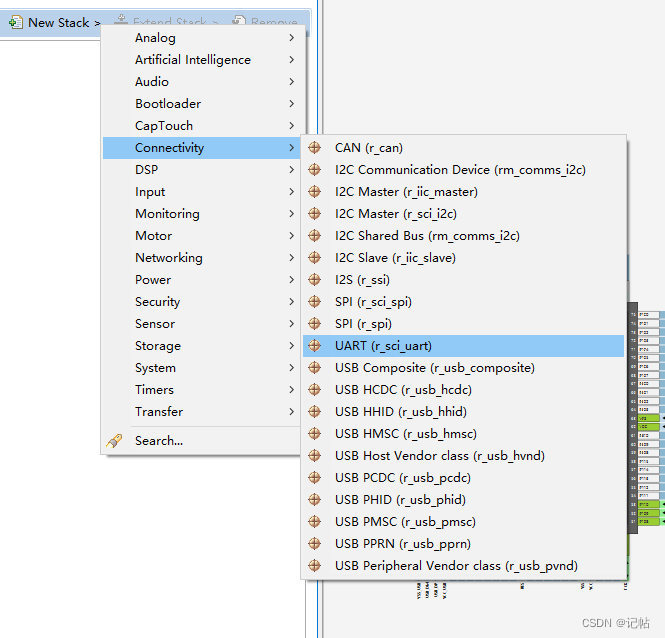
UART属性配置
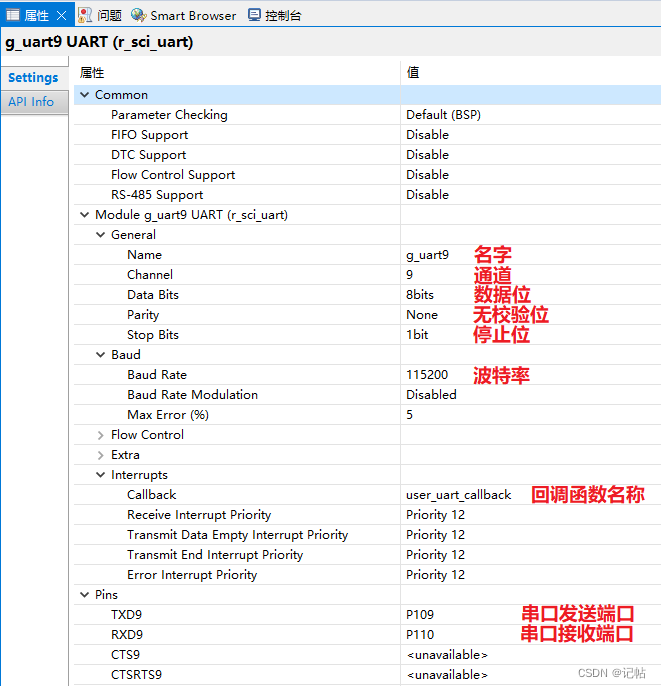
设置e2studio堆栈
printf函数通常需要设置堆栈大小。这是因为printf函数在运行时需要使用栈空间来存储临时变量和函数调用信息。如果堆栈大小不足,可能会导致程序崩溃或不可预期的行为。 printf函数使用了可变参数列表,它会在调用时使用栈来存储参数,在函数调用结束时再清除参数,这需要足够的栈空间。另外printf也会使用一些临时变量,如果栈空间不足,会导致程序崩溃。 因此,为了避免这类问题,应该根据程序的需求来合理设置堆栈大小。
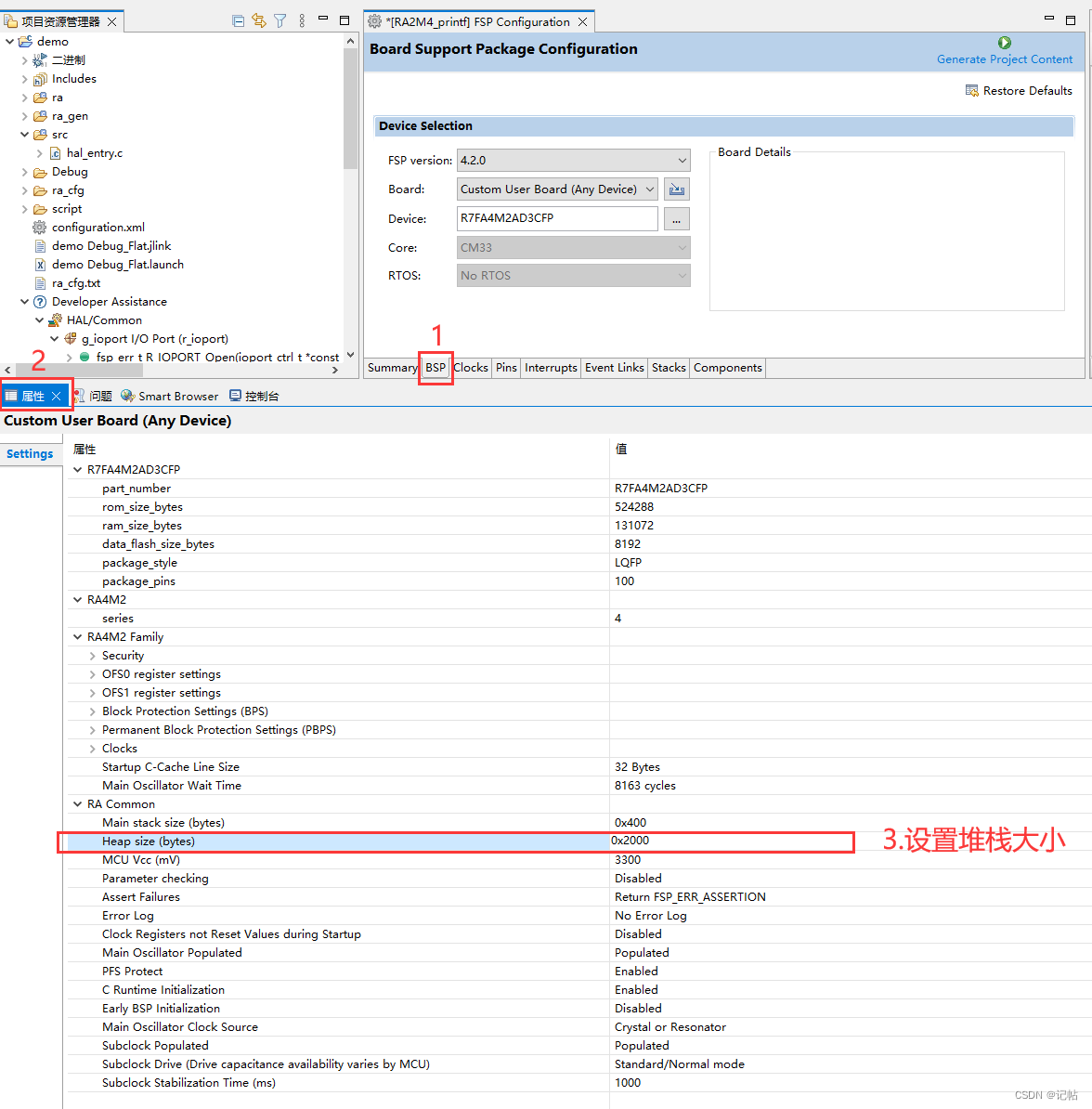
e2studio的重定向printf设置
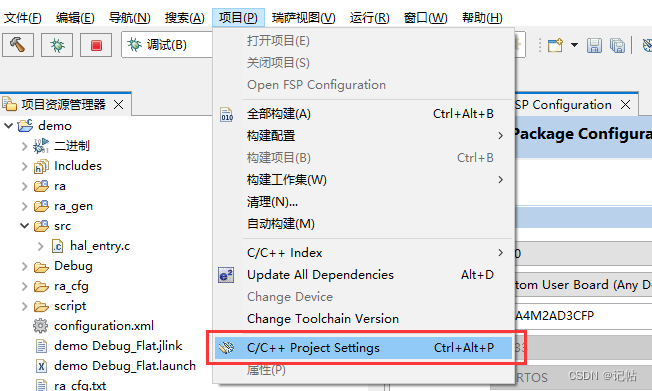
在嵌入式系统的开发中,尤其是在使用GNU编译器集合(GCC)时,–specs 参数用于指定链接时使用的系统规格(specs)文件。这些规格文件控制了编译器和链接器的行为,尤其是关于系统库和启动代码的链接。–specs=rdimon.specs 和 --specs=nosys.specs 是两种常见的规格文件,它们用于不同的场景。
–specs=rdimon.specs
用途: 这个选项用于链接“Redlib”库,这是为裸机(bare-metal)和半主机(semihosting)环境设计的C库的一个变体。半主机环境是一种特殊的运行模式,允许嵌入式程序通过宿主机(如开发PC)的调试器进行输入输出操作。
应用场景: 当你需要在没有完整操作系统的环境中运行程序,但同时需要使用调试器来处理输入输出(例如打印到宿主机的终端),这个选项非常有用。
特点: 它提供了一些基本的系统调用,通过调试接口与宿主机通信。
–specs=nosys.specs
用途: 这个选项链接了一个非常基本的系统库,这个库不提供任何系统服务的实现。
应用场景: 适用于完全的裸机程序,其中程序不执行任何操作系统调用,比如不进行文件操作或者系统级输入输出。
特点: 这是一个更“裸”的环境,没有任何操作系统支持。使用这个规格文件,程序不期望有操作系统层面的任何支持。
如果你的程序需要与宿主机进行交互(如在开发期间的调试),并且通过调试器进行基本的输入输出操作,则使用 --specs=rdimon.specs。
如果你的程序是完全独立的,不需要任何形式的操作系统服务,包括不进行任何系统级的输入输出,则使用 --specs=nosys.specs。
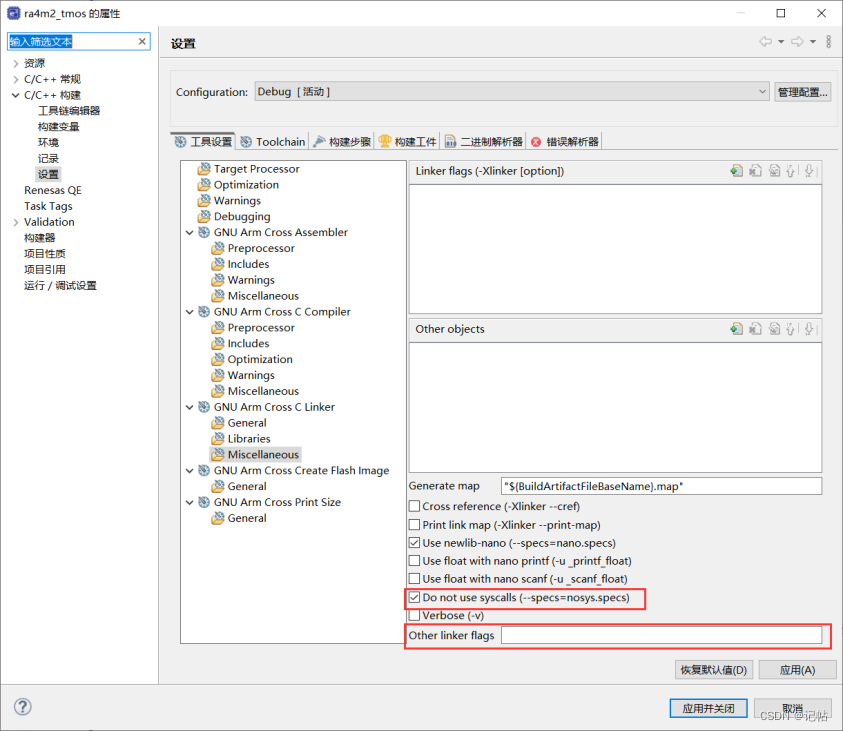
R_SCI_UART_Open()函数原型
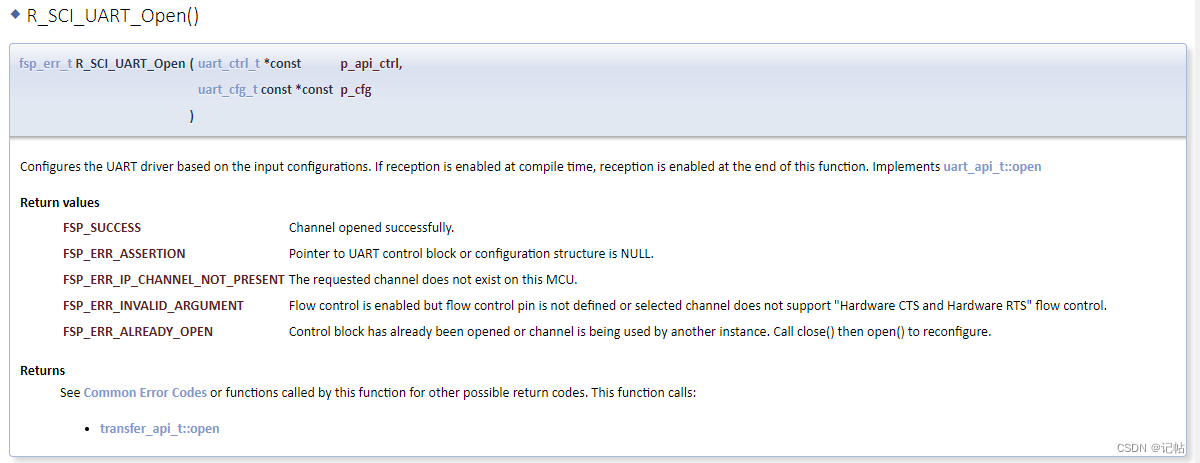
故可以用 R_SCI_UART_Open()函数进行配置,开启和初始化UART。
/* Open the transfer instance with initial configuration. */
err = R_SCI_UART_Open(&g_uart9_ctrl, &g_uart9_cfg);
assert(FSP_SUCCESS == err);
回调函数user_uart_callback ()
当数据发送的时候,可以查看UART_EVENT_TX_COMPLETE来判断是否发送完毕。

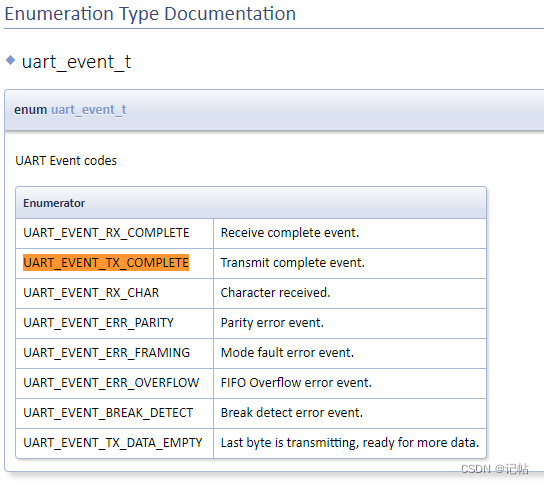
可以检查检查 "p_args" 结构体中的 "event" 字段的值是否等于 "UART_EVENT_TX_COMPLETE"。如果条件为真,那么 if 语句后面的代码块将会执行。
fsp_err_t err = FSP_SUCCESS;
volatile bool uart_send_complete_flag = false;
void user_uart_callback (uart_callback_args_t * p_args)
{
if(p_args- >event == UART_EVENT_TX_COMPLETE)
{
uart_send_complete_flag = true;
}
}
printf输出重定向到串口
打印最常用的方法是printf,所以要解决的问题是将printf的输出重定向到串口,然后通过串口将数据发送出去。 注意一定要加上头文件#include
#ifdef __GNUC__ //串口重定向
#define PUTCHAR_PROTOTYPE int __io_putchar(int ch)
#else
#define PUTCHAR_PROTOTYPE int fputc(int ch, FILE *f)
#endif
PUTCHAR_PROTOTYPE
{
err = R_SCI_UART_Write(&g_uart9_ctrl, (uint8_t *)&ch, 1);
if(FSP_SUCCESS != err) __BKPT();
while(uart_send_complete_flag == false){}
uart_send_complete_flag = false;
return ch;
}
int _write(int fd,char *pBuffer,int size)
{
for(int i=0;i< size;i++)
{
__io_putchar(*pBuffer++);
}
return size;
}
IIC属性配置
查看手册,可以得知LPS28DFW的IIC地址为“1011100” 或者 “1011101”,即0x5C或0x5D。
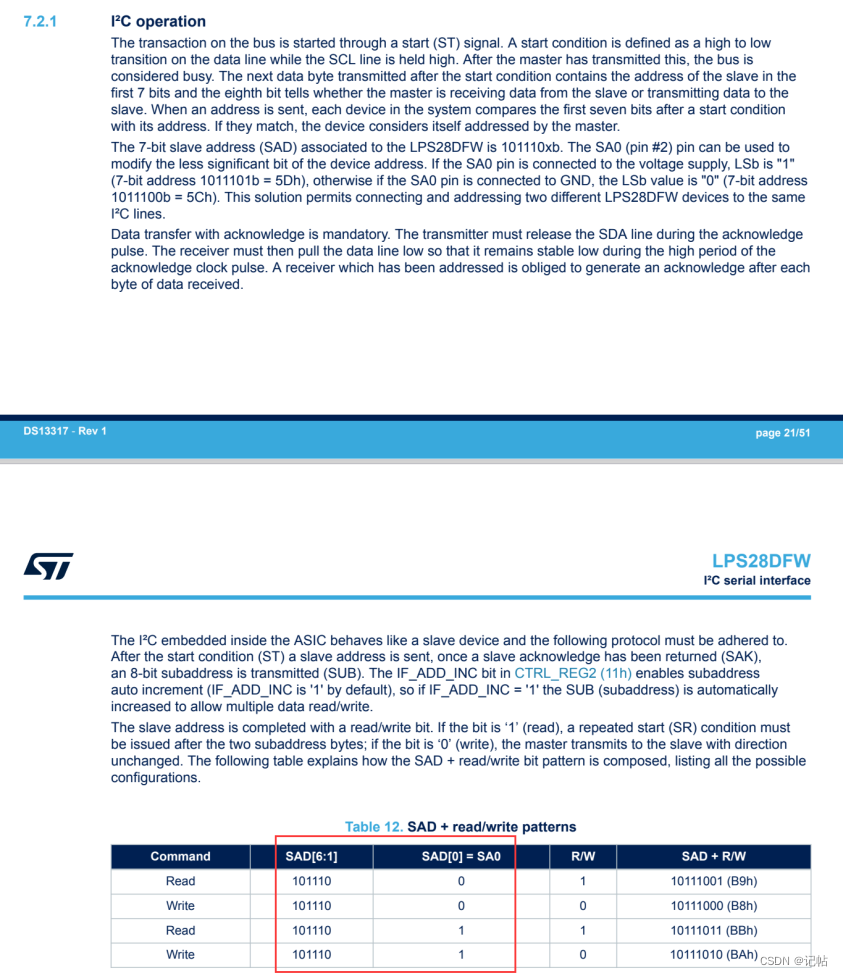
IIC配置
配置RA4M2的I2C接口,使其作为I2C master进行通信。 查看开发板原理图,对应的IIC为P407和P408。
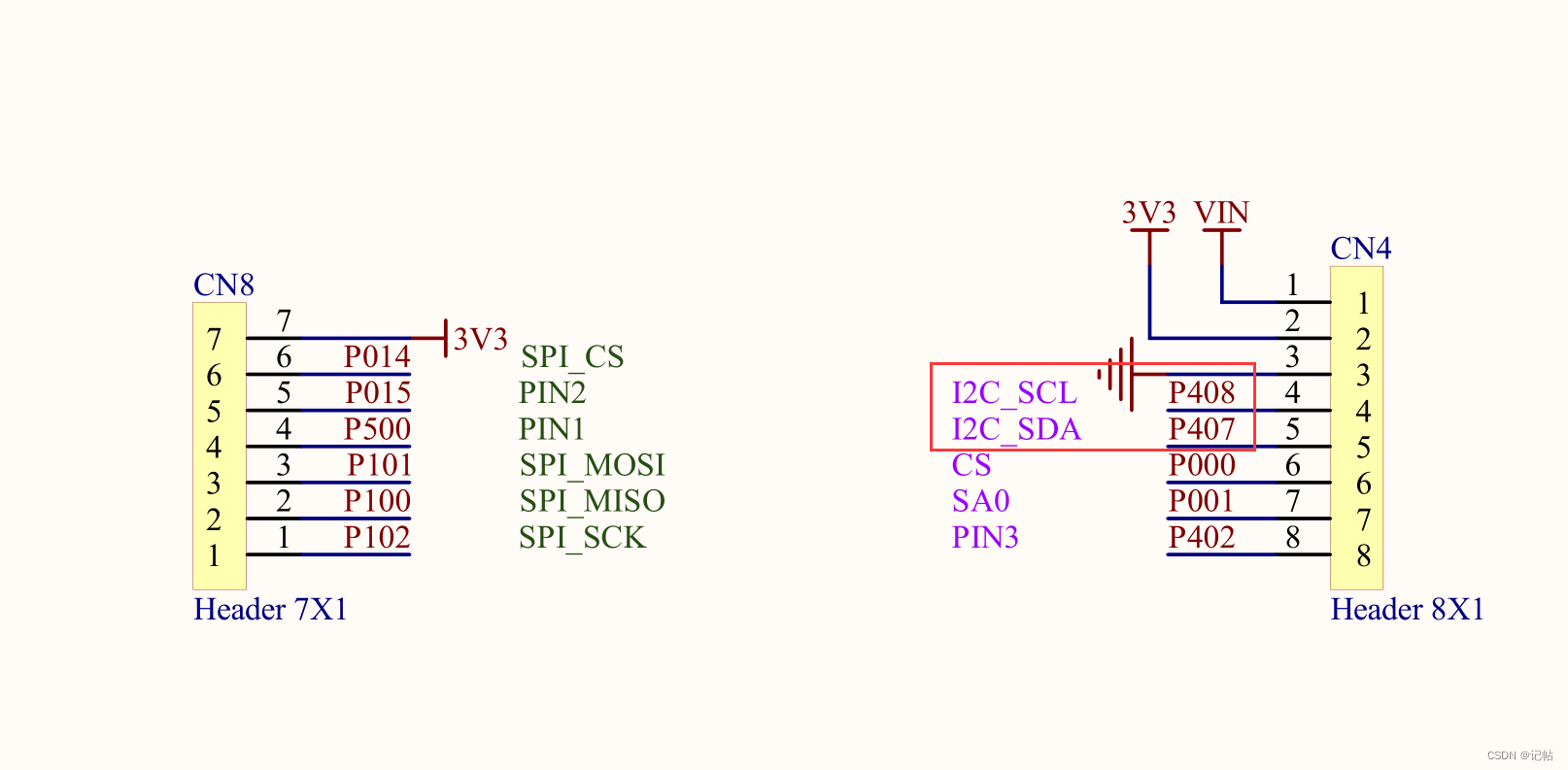
点击Stacks->New Stack->Connectivity -> I2C Master(r_iic_master)。
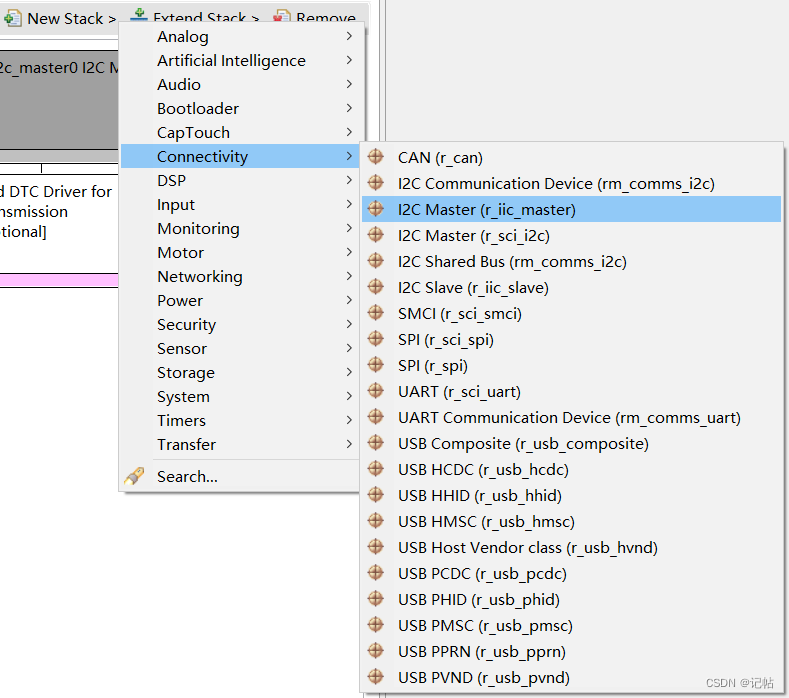
设置IIC的配置,需要注意从机的地址。

R_IIC_MASTER_Open()函数原型
R_IIC_MASTER_Open()函数为执行IIC初始化,开启配置如下所示。
/* Initialize the I2C module */
err = R_IIC_MASTER_Open(&g_i2c_master0_ctrl, &g_i2c_master0_cfg);
/* Handle any errors. This function should be defined by the user. */
assert(FSP_SUCCESS == err);
R_IIC_MASTER_Write()函数原型
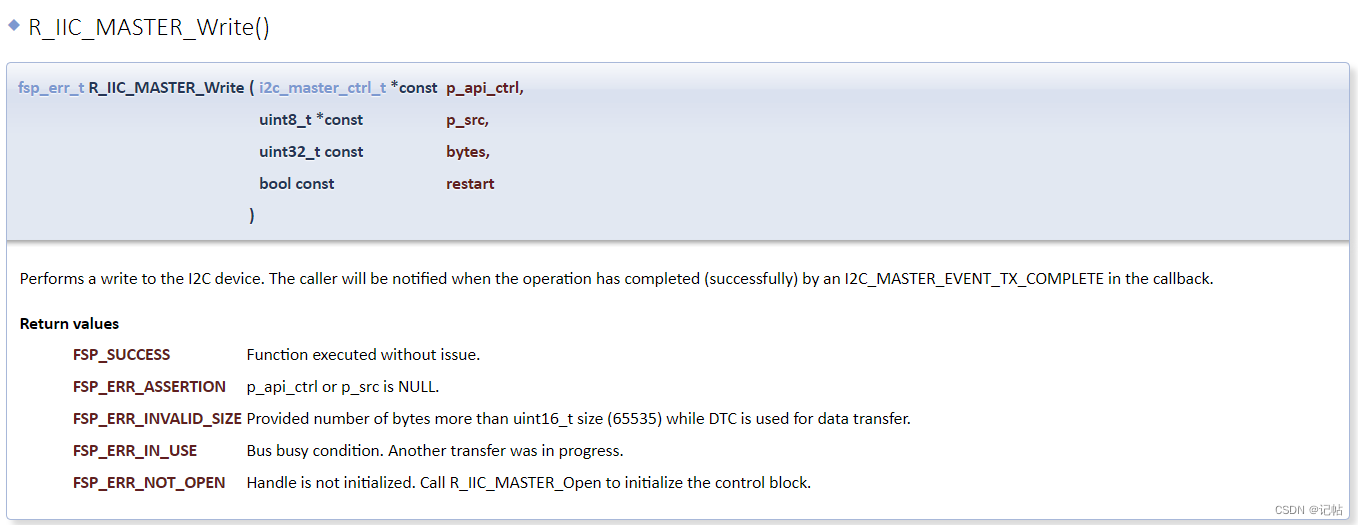
R_IIC_MASTER_Write()函数是向IIC设备中写入数据,写入格式如下所示。
err = R_IIC_MASTER_Write(&g_i2c_master0_ctrl, ®, 1, true);
assert(FSP_SUCCESS == err);
R_IIC_MASTER_Read()函数原型

R_SCI_I2C_Read()函数是向IIC设备中读取数据,读取格式如下所示。
/* Read data from I2C slave */
err = R_IIC_MASTER_Read(&g_i2c_master0_ctrl, bufp, len, false);
assert(FSP_SUCCESS == err);
sci_i2c_master_callback()回调函数
对于数据是否发送完毕,可以查看是否获取到I2C_MASTER_EVENT_TX_COMPLETE字段。

/* Callback function */
i2c_master_event_t i2c_event = I2C_MASTER_EVENT_ABORTED;
uint32_t timeout_ms = 100000;
void sci_i2c_master_callback(i2c_master_callback_args_t *p_args)
{
i2c_event = I2C_MASTER_EVENT_ABORTED;
if (NULL != p_args)
{
/* capture callback event for validating the i2c transfer event*/
i2c_event = p_args- >event;
}
}
SA0地址设置
通过设置SA0管脚的高低电平可以改变模块的地址。
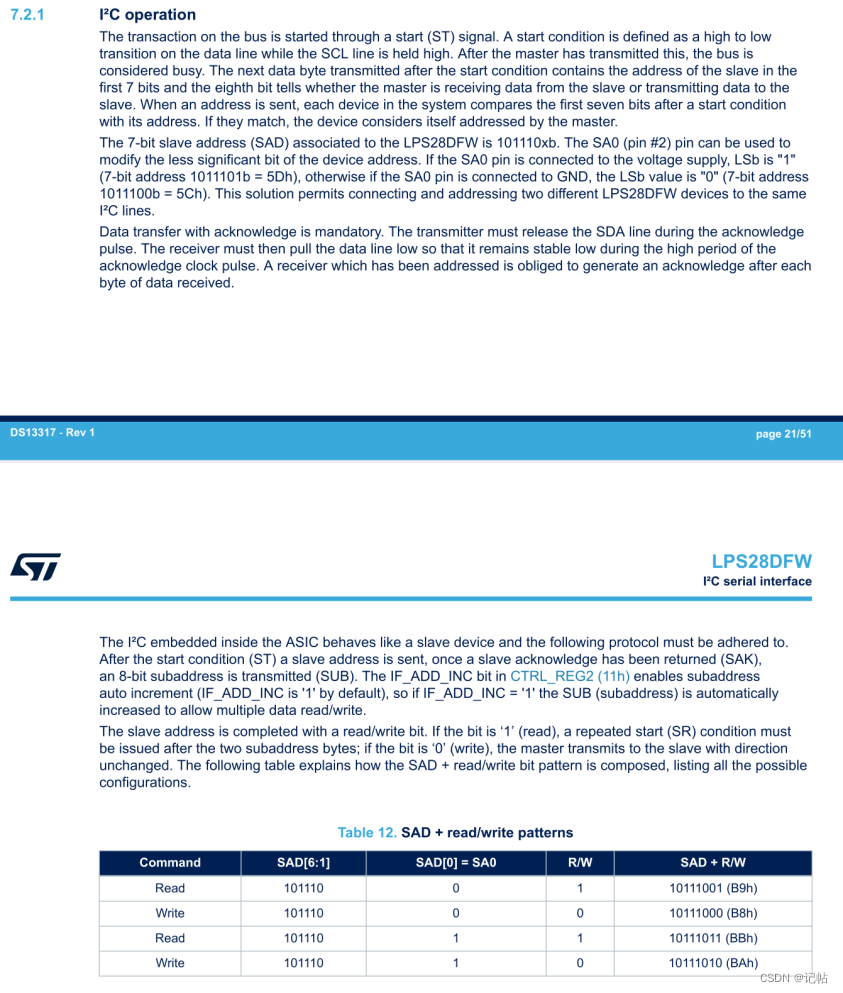
这里设置SA0管脚位输出管脚。

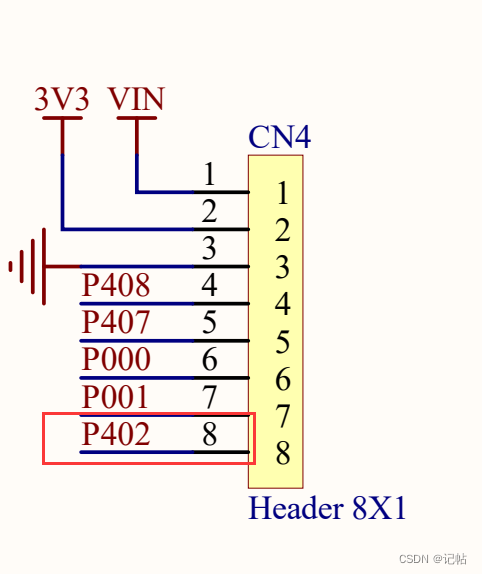

参考程序
[https://github.com/STMicroelectronics/lps28dfw-pid]
SA0设置模块地址
使能SA0为低电平,配置模块地址。

lps28dfw_pin_int_route_t int_route;
lps28dfw_all_sources_t all_sources;
lps28dfw_bus_mode_t bus_mode;
lps28dfw_stat_t status;
stmdev_ctx_t dev_ctx;
lps28dfw_id_t id;
lps28dfw_md_t md;
/* Initialize mems driver interface */
dev_ctx.write_reg = platform_write;
dev_ctx.read_reg = platform_read;
dev_ctx.handle = &SENSOR_BUS;
HAL_GPIO_WritePin(SA0_GPIO_Port, SA0_Pin, GPIO_PIN_RESET);
/* Wait sensor boot time */
platform_delay(BOOT_TIME);
获取ID
可以向WHO_AM_I (0Fh)获取固定值,判断是否为0xB4

lps28dfw_id_get为获取函数。
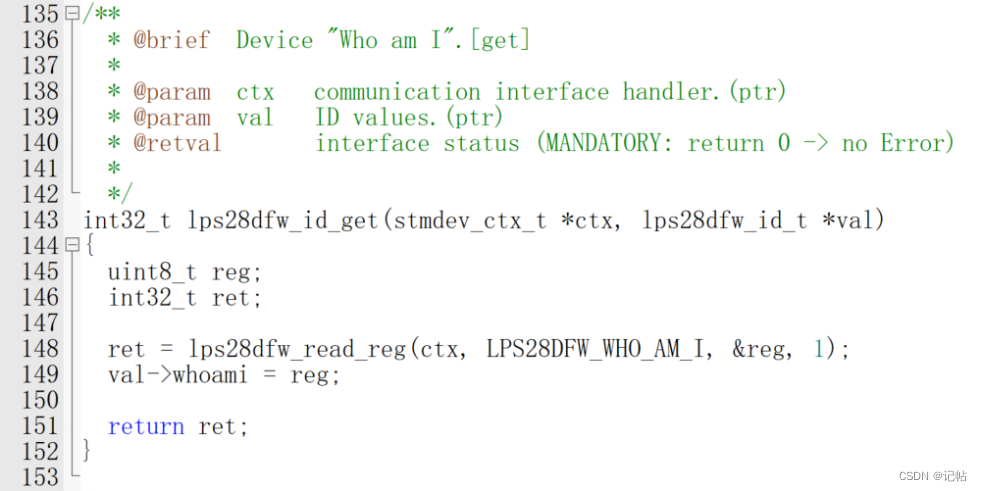
对应的获取ID驱动程序,如下所示。
/* Check device ID */
lps28dfw_id_get(&dev_ctx, &id);
printf("LPS28DFW_ID=0x%x,id.whoami=0x%xn",LPS28DFW_ID,id.whoami);
if (id.whoami != LPS28DFW_ID)
while(1);
复位操作
lps28dfw_init_set为重置函数。
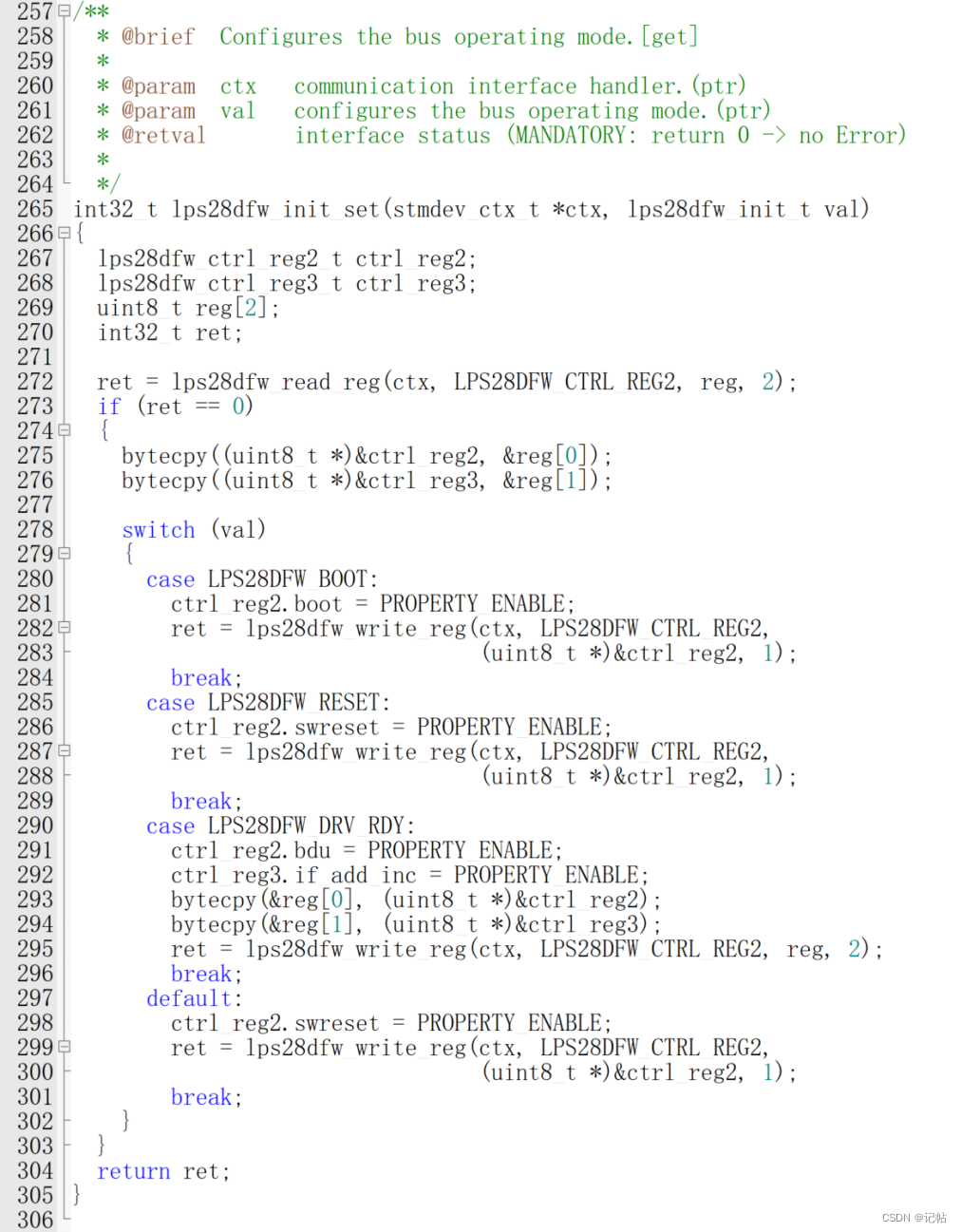
对应的驱动程序,如下所示。
/* Restore default configuration */
lps28dfw_init_set(&dev_ctx, LPS28DFW_RESET);
do {
lps28dfw_status_get(&dev_ctx, &status);
} while (status.sw_reset);
BDU设置
在很多传感器中,数据通常被存储在输出寄存器中,这些寄存器分为两部分:MSB和LSB。这两部分共同表示一个完整的数据值。例如,在一个加速度计中,MSB和LSB可能共同表示一个加速度的测量值。
连续更新模式(BDU = '0'):在默认模式下,输出寄存器的值会持续不断地被更新。这意味着在你读取MSB和LSB的时候,寄存器中的数据可能会因为新的测量数据而更新。这可能导致一个问题:当你读取MSB时,如果寄存器更新了,接下来读取的LSB可能就是新的测量值的一部分,而不是与MSB相对应的值。这样,你得到的就是一个“拼凑”的数据,它可能无法准确代表任何实际的测量时刻。
块数据更新(BDU)模式(BDU = '1'):当激活BDU功能时,输出寄存器中的内容不会在读取MSB和LSB之间更新。这就意味着一旦开始读取数据(无论是先读MSB还是LSB),寄存器中的那一组数据就被“锁定”,直到两部分都被读取完毕。这样可以确保你读取的MSB和LSB是同一测量时刻的数据,避免了读取到代表不同采样时刻的数据。
简而言之,BDU位的作用是确保在读取数据时,输出寄存器的内容保持稳定,从而避免读取到拼凑或错误的数据。这对于需要高精度和稳定性的应用尤为重要。
可以向CFG_REG_C (62h)的BDU寄存器写入1进行开启。
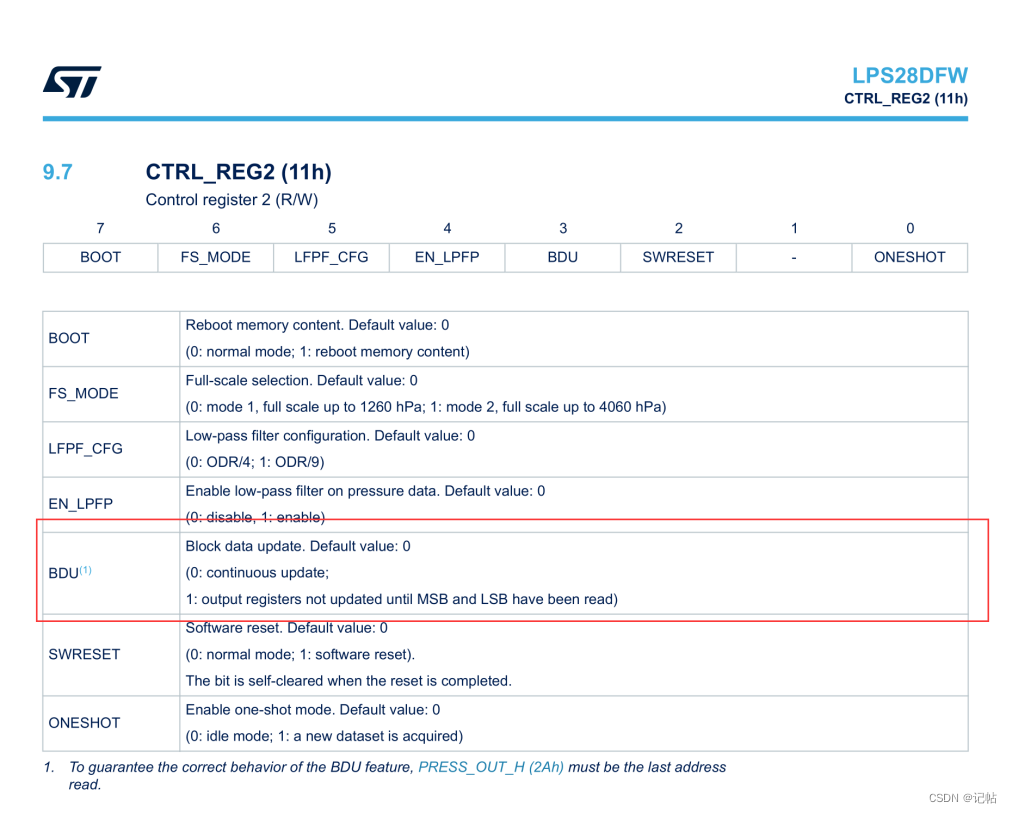
对应的驱动程序,如下所示。
/* Set bdu and if_inc recommended for driver usage */
lps28dfw_init_set(&dev_ctx, LPS28DFW_DRV_RDY);
设置总线接口
/* Select bus interface */
bus_mode.filter = LPS28DFW_AUTO;
bus_mode.interface = LPS28DFW_SEL_BY_HW;
lps28dfw_bus_mode_set(&dev_ctx, &bus_mode);
设置速率
设置速率和量程可以通过CTRL_REG1 (10h)和CTRL_REG2 (11h)进行设置。
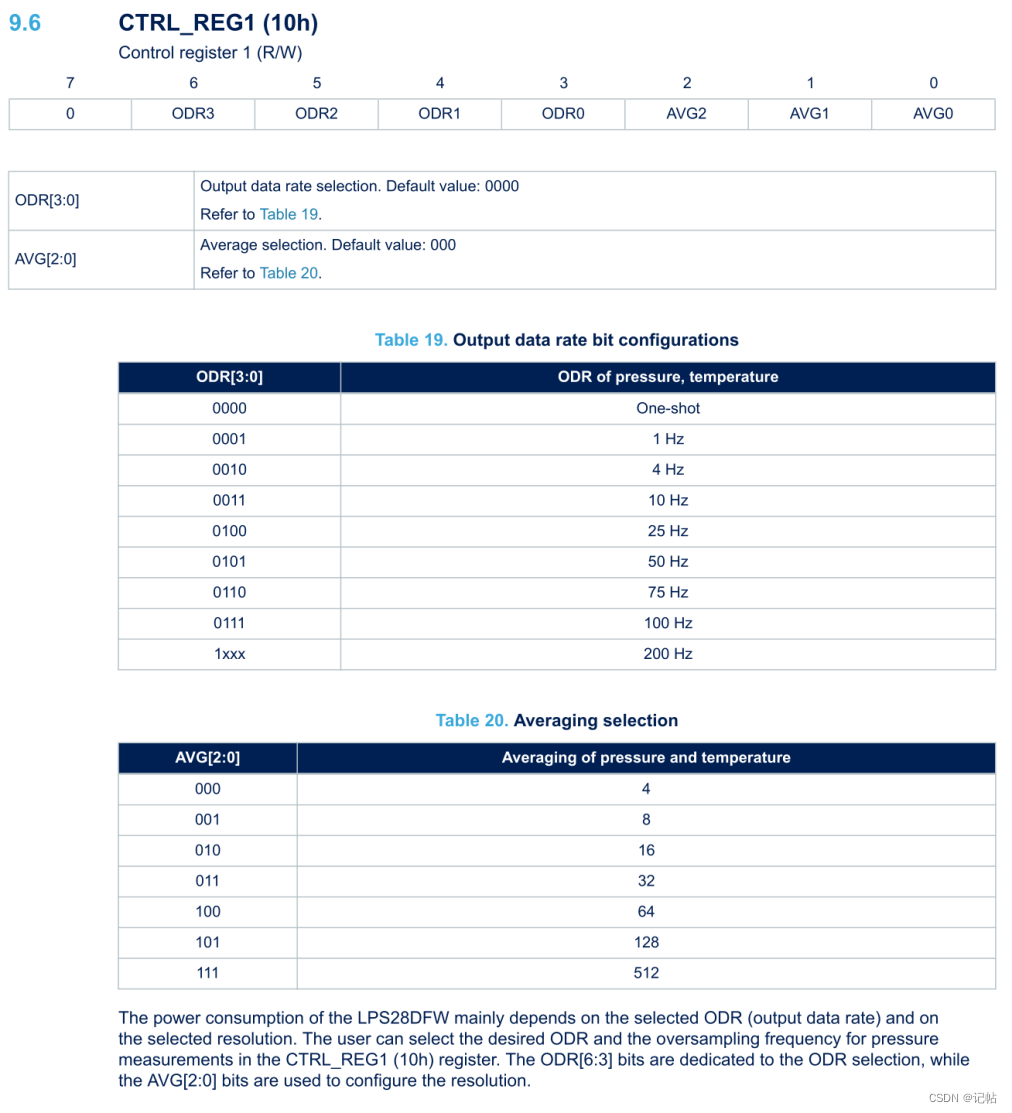
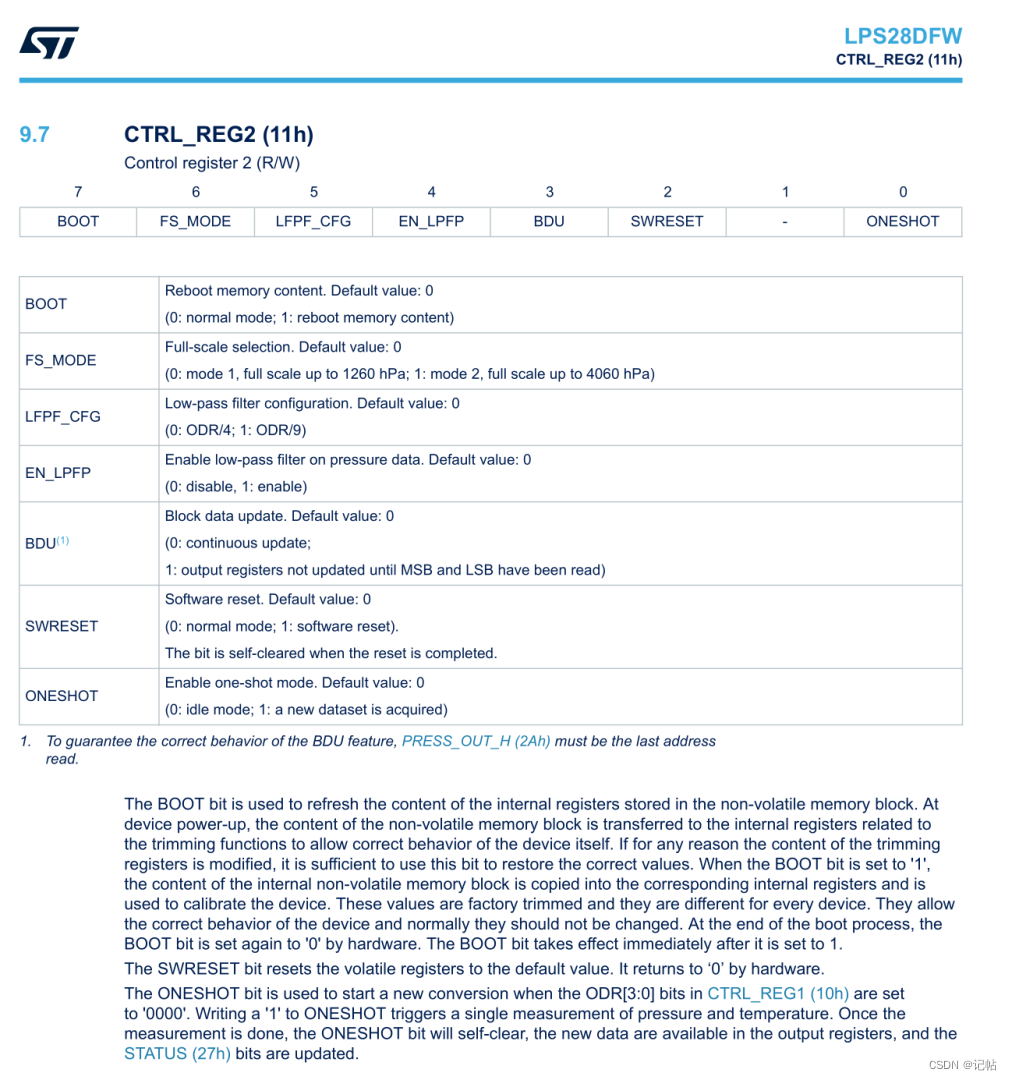
/* Set Output Data Rate */
md.odr = LPS28DFW_4Hz;
md.avg = LPS28DFW_16_AVG;
md.lpf = LPS28DFW_LPF_ODR_DIV_4;
md.fs = LPS28DFW_1260hPa;
lps28dfw_mode_set(&dev_ctx, &md);
中断配置
CTRL_REG4 (13h) 寄存器在 LPS28DFW 气压传感器中用于控制与中断相关的不同功能。以下是具体的位字段及其功能:
- DRDY_PLS (位 6):在 INT_DRDY 引脚上启用数据就绪脉冲。默认值为 0(0:禁用;1:启用在 INT_DRDY 引脚上的数据就绪脉冲,脉冲宽度约 5 微秒)。
- DRDY (位 5):在 INT_DRDY 引脚上的数据就绪信号。默认值为 0(0:禁用;1:启用)。
- INT_EN (位 4):在 INT_DRDY 引脚上的中断信号。默认值为 0(0:禁用;1:启用)。
- INT_F_FULL (位 2):在 INT_DRDY 引脚上的 FIFO 满标志。默认值为 0(0:FIFO 为空;1:FIFO 满,有 128 个未读样本)。
- INT_F_WTM (位 1):在 INT_DRDY 引脚上的 FIFO 阈值(水位标记)状态。默认值为 0(0:FIFO 低于 WTM 级别;1:FIFO 等于或高于 WTM 级别)。
- INT_F_OVR (位 0):在 INT_DRDY 引脚上的 FIFO 溢出状态。默认值为 0(0:未溢出;1:FIFO 中至少有一个样本被覆盖)。 这些设置允许用户配置传感器的中断行为,包括数据就绪通知、FIFO 相关的状态通知等。通过正确配置这些位,可以根据特定的应用需求调整传感器的行为,优化数据采集和处理效率。
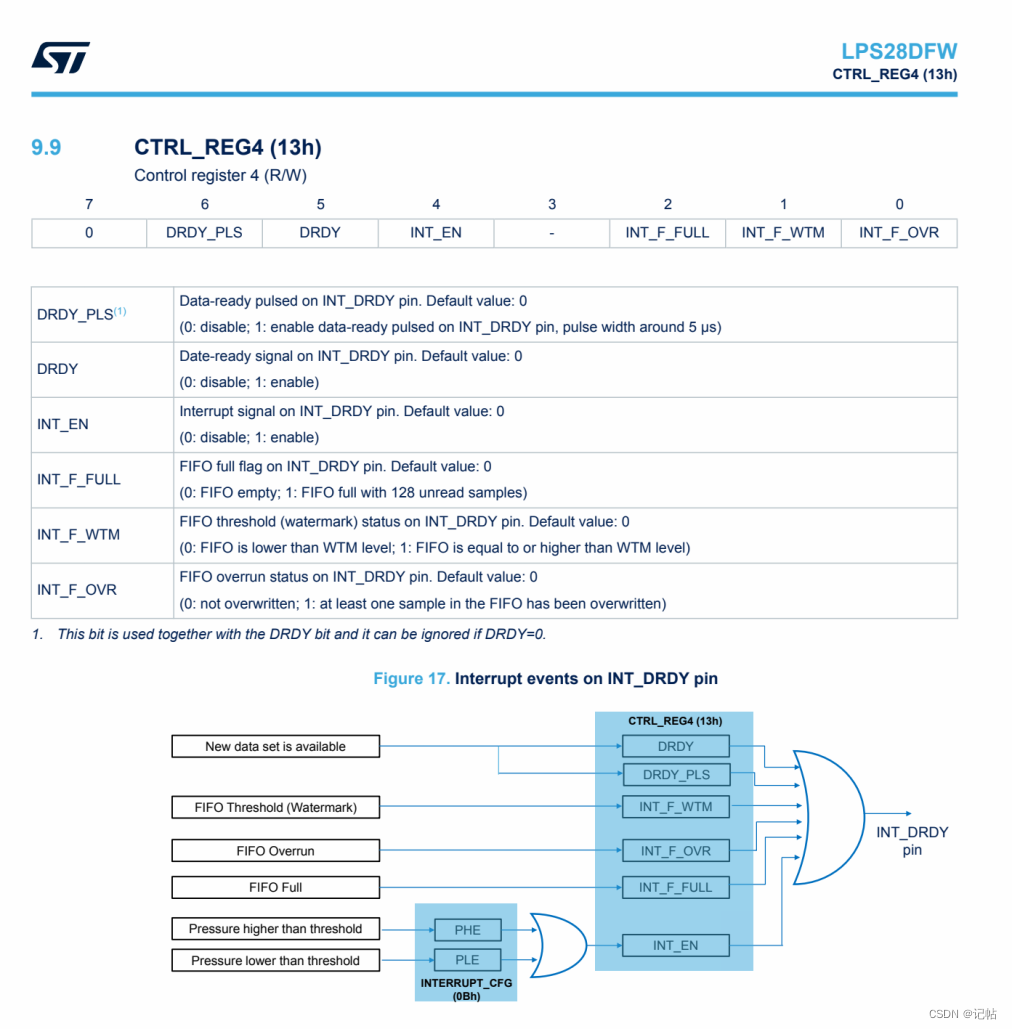
/* Configure inerrupt pins */
lps28dfw_pin_int_route_get(&dev_ctx, &int_route);
int_route.drdy_pres = PROPERTY_DISABLE;
lps28dfw_pin_int_route_set(&dev_ctx, &int_route);
轮询读取数据
对于压强和温度数据是否准备好,可以查看STATUS (27h)的Zyxda位,判断是否有新数据到达。
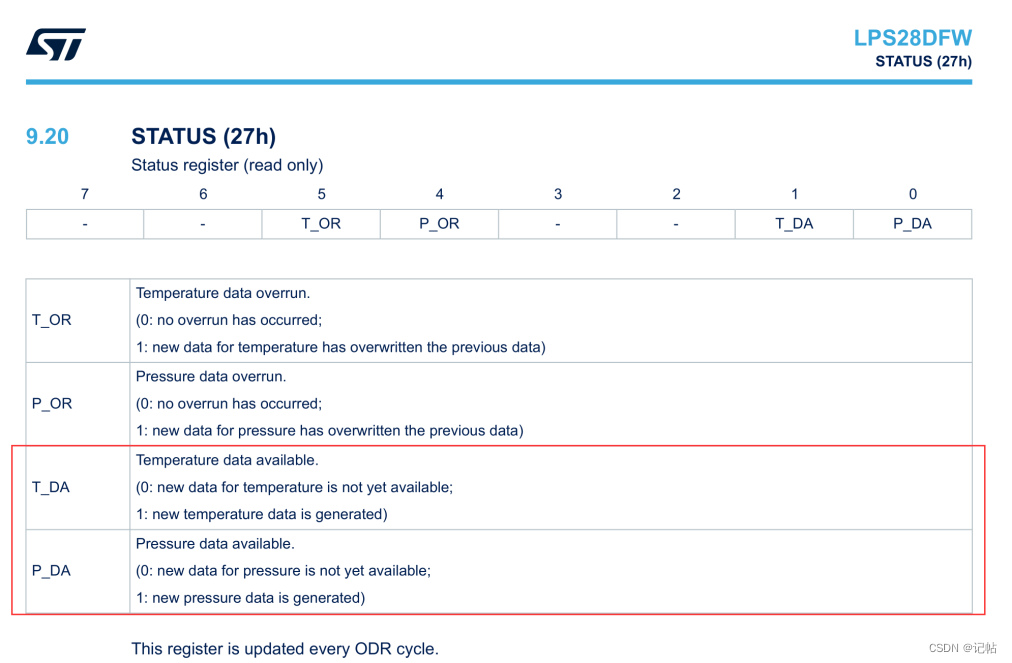
对于压强数据,主要在PRESS_OUT_XL (28h)-PRESS_OUT_H (2Ah)。
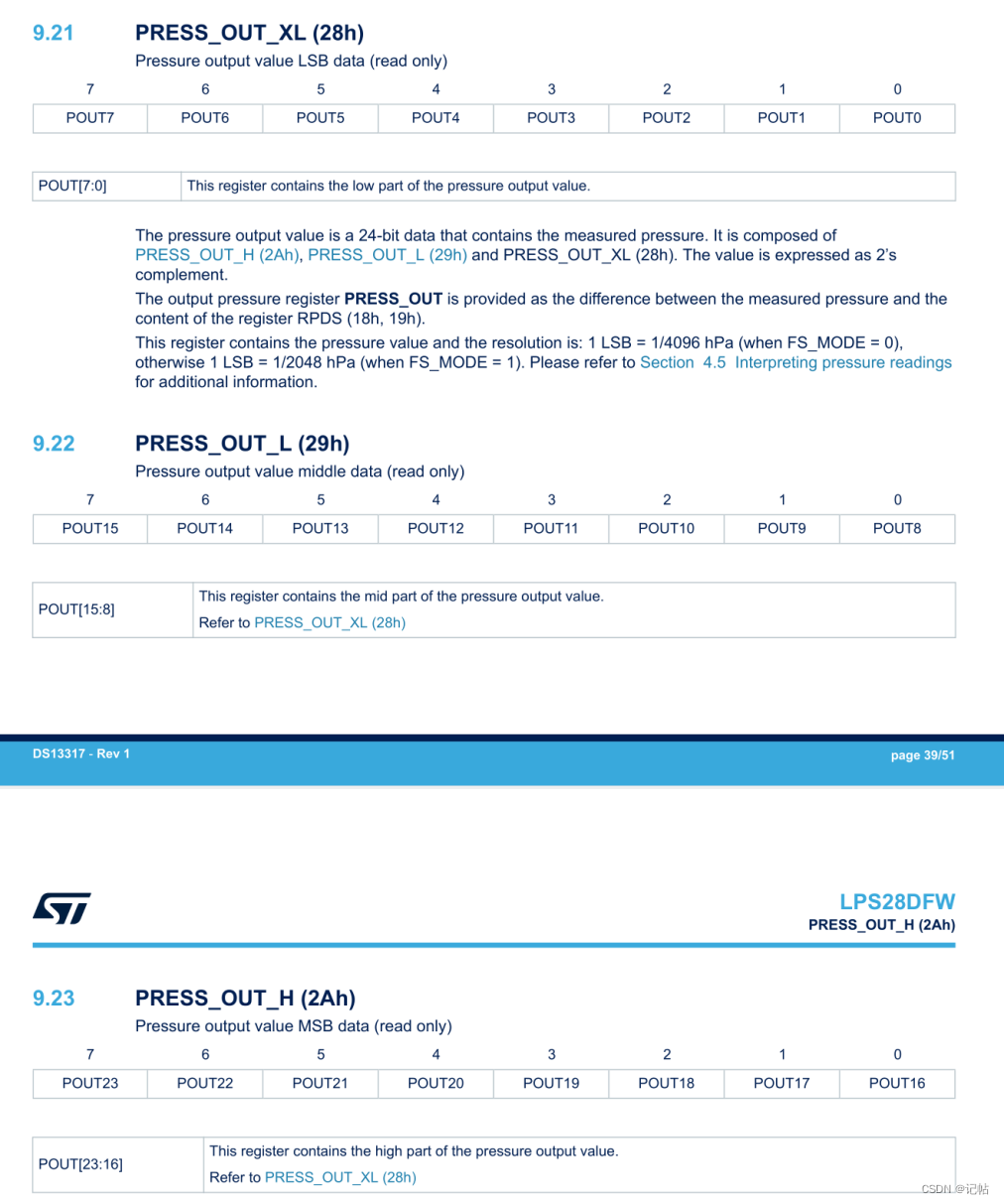
对于温度数据,数据在TEMP_OUT_L (2Bh)-TEMP_OUT_H (2Ch)。
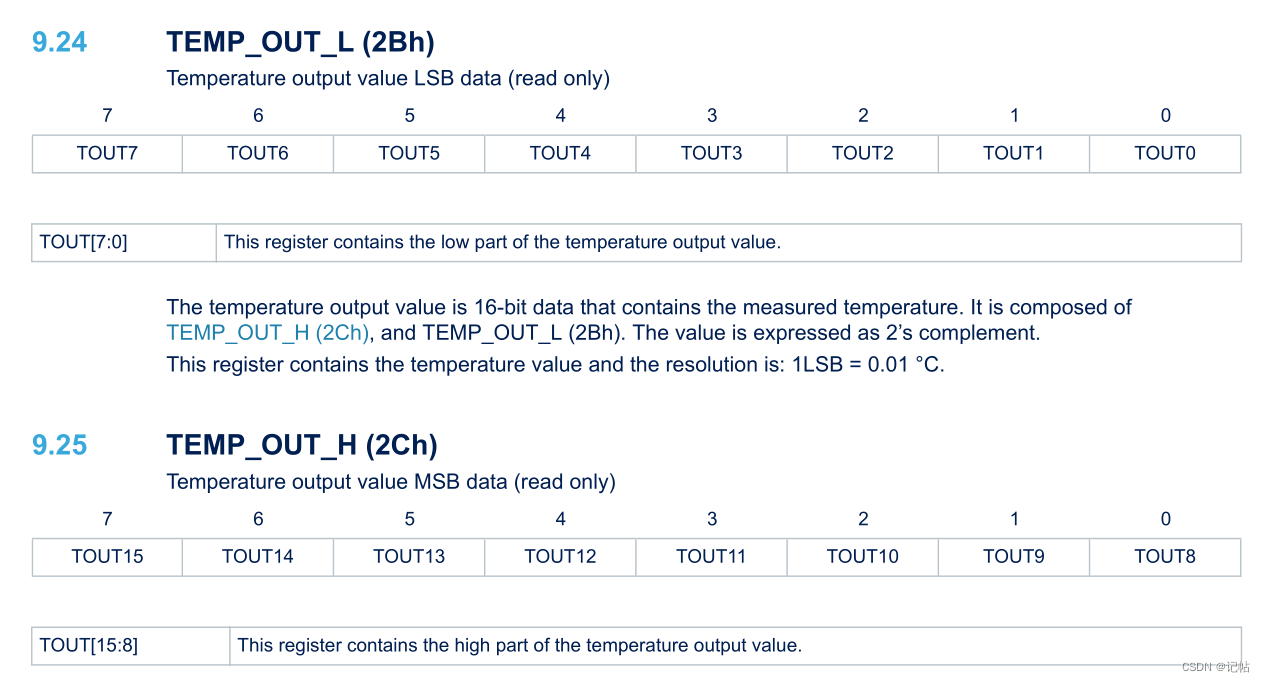
while (1)
{
/* Read output only if new values are available */
lps28dfw_all_sources_get(&dev_ctx, &all_sources);
if ( all_sources.drdy_pres | all_sources.drdy_temp ) {
lps28dfw_data_get(&dev_ctx, &md, &data);
printf("pressure [hPa]:%6.2f temperature [degC]:%6.2frn",data.pressure.hpa, data.heat.deg_c);
}
}
演示
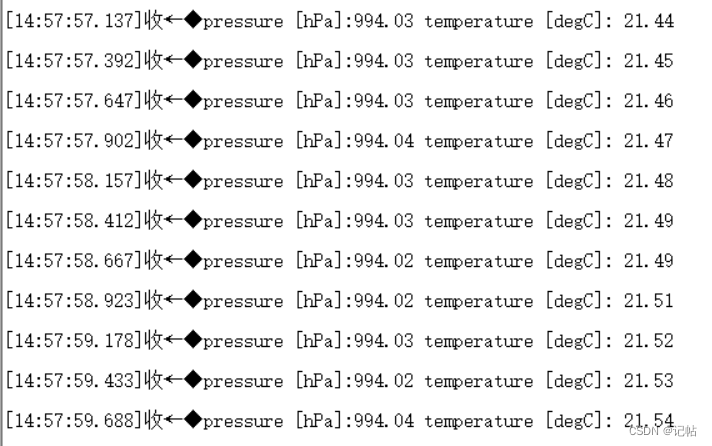 正常气压为50hPa到1050hPa之间。
正常气压为50hPa到1050hPa之间。
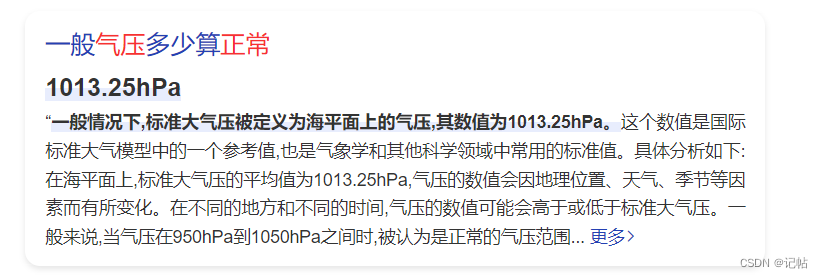
主程序
#include "hal_data.h"
#include "lps28dfw_reg.h"
#include < stdio.h >
fsp_err_t err = FSP_SUCCESS;
volatile bool uart_send_complete_flag = false;
void user_uart_callback (uart_callback_args_t * p_args)
{
if(p_args- >event == UART_EVENT_TX_COMPLETE)
{
uart_send_complete_flag = true;
}
}
/* Callback function */
i2c_master_event_t i2c_event = I2C_MASTER_EVENT_ABORTED;
uint32_t timeout_ms = 100000;
void sci_i2c_master_callback(i2c_master_callback_args_t *p_args)
{
i2c_event = I2C_MASTER_EVENT_ABORTED;
if (NULL != p_args)
{
/* capture callback event for validating the i2c transfer event*/
i2c_event = p_args- >event;
}
}
#ifdef __GNUC__ //串口重定向
#define PUTCHAR_PROTOTYPE int __io_putchar(int ch)
#else
#define PUTCHAR_PROTOTYPE int fputc(int ch, FILE *f)
#endif
PUTCHAR_PROTOTYPE
{
err = R_SCI_UART_Write(&g_uart9_ctrl, (uint8_t *)&ch, 1);
if(FSP_SUCCESS != err) __BKPT();
while(uart_send_complete_flag == false){}
uart_send_complete_flag = false;
return ch;
}
int _write(int fd,char *pBuffer,int size)
{
for(int i=0;i< size;i++)
{
__io_putchar(*pBuffer++);
}
return size;
}
FSP_CPP_HEADER
void R_BSP_WarmStart(bsp_warm_start_event_t event);
FSP_CPP_FOOTER
#define BOOT_TIME 10 //ms
#define SENSOR_BUS g_i2c_master0_ctrl
/* Private variables ---------------------------------------------------------*/
static uint8_t tx_buffer[1000];
static lps28dfw_data_t data;
/* Private functions ---------------------------------------------------------*/
/*
* WARNING:
* Functions declare in this section are defined at the end of this file
* and are strictly related to the hardware platform used.
*
*/
static int32_t platform_write(void *handle, uint8_t reg, const uint8_t *bufp,
uint16_t len);
static int32_t platform_read(void *handle, uint8_t reg, uint8_t *bufp,
uint16_t len);
static void tx_com( uint8_t *tx_buffer, uint16_t len );
static void platform_delay(uint32_t ms);
static void platform_init(void);
/*******************************************************************************************************************//**
* main() is generated by the RA Configuration editor and is used to generate threads if an RTOS is used. This function
* is called by main() when no RTOS is used.
**********************************************************************************************************************/
void hal_entry(void)
{
/* TODO: add your own code here */
/* Open the transfer instance with initial configuration. */
err = R_SCI_UART_Open(&g_uart9_ctrl, &g_uart9_cfg);
assert(FSP_SUCCESS == err);
printf("hello world!n");
/* Initialize the I2C module */
err = R_IIC_MASTER_Open(&g_i2c_master0_ctrl, &g_i2c_master0_cfg);
/* Handle any errors. This function should be defined by the user. */
assert(FSP_SUCCESS == err);
R_IOPORT_PinWrite(&g_ioport_ctrl, BSP_IO_PORT_04_PIN_05, BSP_IO_LEVEL_LOW);
lps28dfw_pin_int_route_t int_route;
lps28dfw_all_sources_t all_sources;
lps28dfw_bus_mode_t bus_mode;
lps28dfw_stat_t status;
stmdev_ctx_t dev_ctx;
lps28dfw_id_t id;
lps28dfw_md_t md;
/* Initialize mems driver interface */
dev_ctx.write_reg = platform_write;
dev_ctx.read_reg = platform_read;
dev_ctx.handle = &SENSOR_BUS;
/* Wait sensor boot time */
platform_delay(BOOT_TIME);
/* Check device ID */
lps28dfw_id_get(&dev_ctx, &id);
printf("LPS28DFW_ID=0x%x,id.whoami=0x%xn",LPS28DFW_ID,id.whoami);
if (id.whoami != LPS28DFW_ID)
while(1);
/* Restore default configuration */
lps28dfw_init_set(&dev_ctx, LPS28DFW_RESET);
do {
lps28dfw_status_get(&dev_ctx, &status);
} while (status.sw_reset);
/* Set bdu and if_inc recommended for driver usage */
lps28dfw_init_set(&dev_ctx, LPS28DFW_DRV_RDY);
/* Select bus interface */
bus_mode.filter = LPS28DFW_AUTO;
bus_mode.interface = LPS28DFW_SEL_BY_HW;
lps28dfw_bus_mode_set(&dev_ctx, &bus_mode);
/* Set Output Data Rate */
md.odr = LPS28DFW_4Hz;
md.avg = LPS28DFW_16_AVG;
md.lpf = LPS28DFW_LPF_ODR_DIV_4;
md.fs = LPS28DFW_1260hPa;
lps28dfw_mode_set(&dev_ctx, &md);
/* Configure inerrupt pins */
lps28dfw_pin_int_route_get(&dev_ctx, &int_route);
int_route.drdy_pres = PROPERTY_DISABLE;
lps28dfw_pin_int_route_set(&dev_ctx, &int_route);
while (1)
{
/* Read output only if new values are available */
lps28dfw_all_sources_get(&dev_ctx, &all_sources);
if ( all_sources.drdy_pres | all_sources.drdy_temp ) {
lps28dfw_data_get(&dev_ctx, &md, &data);
printf("pressure [hPa]:%6.2f temperature [degC]:%6.2frn",data.pressure.hpa, data.heat.deg_c);
}
}
#if BSP_TZ_SECURE_BUILD
/* Enter non-secure code */
R_BSP_NonSecureEnter();
#endif
}
审核编辑 黄宇
-
气压计LPS28DFW小板开发(2)----水压检测2025-12-22 245
-
STMicroelectronics LPS28DFW 数字气压计技术深度解析与应用指南2025-10-31 354
-
气压计LPS22DF开发(1)----轮询获取气压计数据2024-11-27 2248
-
e2studio开发LPS28DFW气压计(1)----轮询获取气压计数据2024-08-09 2419
-
气压计LPS25HB开发(1)----轮询获取气压计数据2024-05-17 2223
-
e2studio开发LPS28DFW气压计(2)----水压检测2024-01-09 1260
-
气压计LPS28DFW开发(1)----轮询获取气压计数据2023-12-28 1373
-
ST LPS28DFW器件相关的使用信息和应用提示2023-09-07 483
-
LPS28DFW紧凑型压阻绝对气压传感器应用笔记2023-08-01 565
-
COCOFLY 教程——疯壳无人机·系列·飞控开发基础【7】SPI(气压计数据获取)2020-04-07 4069
-
COCOFLY 教程 ——疯壳无人机·系列【7】SPI(气压计数据获取)2020-03-20 3107
-
数字气压计设计与制作解析2018-06-26 1514
全部0条评论

快来发表一下你的评论吧 !

